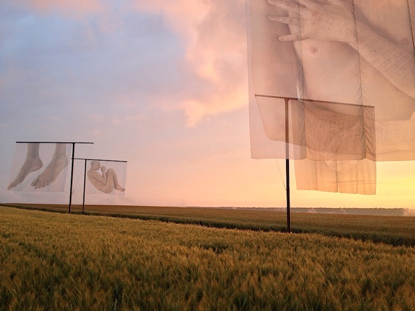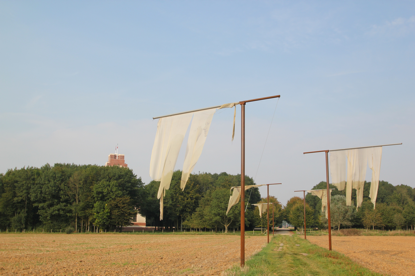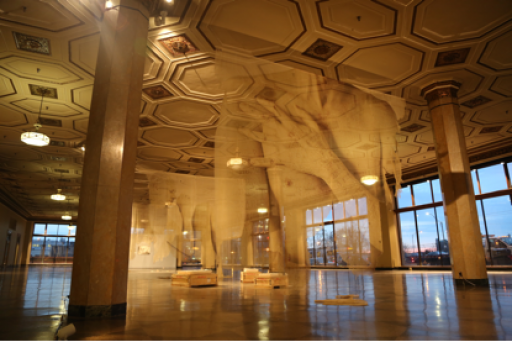Susan Werbe reviews Remnants, South African artist Paul Emmanuel’s installation remembering the missing soldiers of the Somme. It’s on display at Boston University’s 808 Gallery in Boston, Massachusetts, until March 20th 2016. The exhibition is due to return to the Somme as part of commemorations marking the July centenary.
Two years ago South African artist Paul Emmanuel created an extraordinarily powerful and engaging counter memorial installation to mark the 98th anniversary of the Battle of the Somme. With the official support from Institut Français, Mission Centenaire 14-18, and the National Arts Council of South Africa, Lost Men France was installed on an agricultural road in the middle of a wheat field within sight of Edwin Lutyens’s iconic Thiepval Memorial to the Missing.
As a visual artist, Emmanuel brought to his work the intensely human element that the architects of the more traditional war memorials left out as monuments to the war dead were erected across northern France in the decades following following the First World War.

Original installation at Thiepval, July 1st 2014 (Photo courtesy of Paul Emmanuel & Art Source South Africa)
The five 25-square-metre silk banners that form Emmanuel’s memorial featured images of Emmanuel’s body, his flesh embedded with the names of missing soldiers. These names represent French, German, South African, and Allied servicemen reported missing during the Somme action – names that do not appear on the Lutyens memorial, which is dedicated to the British and South African missing. In this way, Emmanuel strives to honor men regardless of their names, rank, ethnicity or nationality who fought and died and disappeared during one of the war’s largest and bloodiest battles.
In order to imprint the selected names on his body, the artist lay in plaster molds in which the names of the missing had been embedded as hard plastic type. The process created bruises on his body – rather like tattooed names – that then were photographed and enlarged into images on the silk banners.
Faded
Emmanuel’s banners hung on their metal poles from July until October – subjected to the winds, rain, and brilliant sun of northern France. Within the first month, the banners began to suffer fading and damage, which Emmanuel saw as a metaphor for the damage done to men’s bodies in time of war. By the end of September, the five banners were bleached shreds of varying sizes, with pieces of the silk resting on the stubbles of the harvested wheat fields.
The shredded banners were taken down in early October and taken back to South Africa, where they were repaired to some degree. The remains of the installation – the remnants – became the next stage of the banners’ journey. With this effort, Emmanuel created a new exhibition, Remnants, which opened on 8 July 2015 in Johannesburg’s Freedom Park, next to memorials to the dead from several South African conflicts.
Remnants continued the conversation that Emmanuel began with Lost Men France “to make the public more broadly aware that a war has lasting psychological effects that are passed from generation to generation…” And by exhibiting Remnants in South Africa, the artist provided a powerful forum for South Africans to examine this history within a uniquely South African context.

Thiepval installation prior to removal of the banners, October 1st 2014. (Photographed by David Thomson. Image courtesy of Paul Emmanuel & Art Source South Africa)
In January of this year, the exhibition moved from Johannesburg to Boston, Massachusetts, where it is on display through March in Boston University’s Gallery 808. Co-curator Pamela Allara writes in the exhibition’s brochure, “Hanging in the 808 Gallery, these ‘Remnants’ are a powerful metaphor for physical and emotional suffering, a memorial to the sine qua non of war: the violation of the human body and the concomitant destruction of human decency.”
Here the exhibition consists of remnants from the five original banners, several of the plaster casts with the names of the missing embedded in the plaster, and original concept drawings. A companion video takes the viewer through the entire creative process from Emmanuel’s researching names of missing soldiers to the process of the artist lying on the casts to embed the names of the missing into his flesh; from photographing his body parts bruised with the names to the final installation in Thiepval, and through time-lapse photography, the inexorable unraveling of the banners.
The 808 Gallery, with its vast spaces and high ceilings, allows the remains of the banners to be hung to best advantage. The viewer is able to walk amongst the banners, stepping carefully around some of the shreds that are placed on the floor, as Emmanuel found them in the Thiepval fields. It is possible to read some of the names; others have been bleached by the sun so that only a few letters remain. Yet the power of Emmanuel’s work is not lessened in its new iteration, rather the force of the exhibition’s themes – “loss, memory, and processes of memorialization” – are underscored by the banners hanging simply and quietly next to the casts that helped to create the original work.
Additions
Additional pieces in the exhibition include a video, Remember-Dismember, which explores the uniforms of war as Emmanuel puts on and takes off the emblems of violence and conflict. The viewer never sees his face, but catches an occasional glimpse of a name pressed into his flesh, including the word “unknown”. Several of Emmanuel ‘s photogravures explore the contemporary landscape of the Western Front; these images offer a more intimate view of the sites that still bear the scars of the carnage that occurred there.
Jonathan Jones in his Guardian August 2014 appraisal of Emmanuel’s Lost Men France installation wrote, “He reminds us in a simple stark way that war is not about ideas or causes or hardware but the destruction of human beings.”
Given permission by France’s Centennial Commission and the ability to secure the necessary funding, Remnants will return to France in July of this year to be installed at the Delville Wood South African Memorial to mark the centenary of the Battle of the Somme.
The current ‘Remnants’ exhibition at 808 Gallery, Boston University, runs until 20 March 2016. Exhibition organized by Pamela Allara and Lynne Cooney.
Art Source South Africa are managers of Paul Emmanuel’s ‘Remnants’.
Submitted by Susan Werbe, co-creator, Letters That You Will Not Get: The Great War Song Cycle
Article: © Centenary News & Author
Images: as credited
